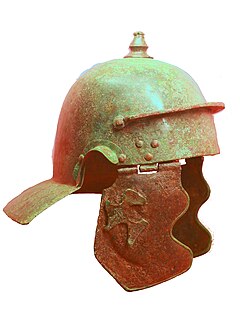
Romula or Malva was an ancient city in Roman Dacia, later the village of Reşca, Dobrosloveni Commune, Olt County, Romania. It was the capital of Dacia Malvensis, one of the three subdivisions of the province of Dacia.
Cohors prima Alpinorum equitata was a Roman auxiliary mixed infantry and cavalry regiment. Alpini was a generic name denoting several Celtic-speaking mountain tribes inhabiting the Alps between Italy and Gaul, which were organised as the Tres Alpes provinces. The regiment was probably raised as one of 4-6 Alpini units recruited after the final annexation of the western Alpine regions by emperor Augustus in 15 BC.

Cohors tertia Delmatarum equitata civium Romanorum pia fidelis, was a Roman auxiliary cohort mixed infantry and cavalry unit.

This article concerns the Roman auxiliary regiments of the Principate period originally recruited in the western Alpine regions of the empire. The cohortes Alpinorum came from Tres Alpes, the three small Roman provinces of the western Alps, Alpes Maritimae, Alpes Cottiae and Alpes Graiae. The cohortes Ligurum were originally raised from the Ligures people of Alpes Maritimae and Liguria regio of NW Italia.

Apulum was a fort in the Roman province of Dacia in the 2nd and 4th centuries AD, located in today's Alba-Iulia, Romania. It is the largest castrum located in Romania, occupying 37.5 hectares.
Cohors VI Thracum quingenaria equitata was a Roman auxiliary regiment containing cavalry contingents. The cohort activated on Dacia and Moesia Inferior provinces. In Dacia the unit stationed on castra from the limes of Dacia Porolissensis: Porolissum, Certinae and Optatiana.

In Roman Dacia an estimated 50,000 troops were stationed at its height.
Cohors [prima] Antiochensium [quingenaria] equitata was a Roman auxiliary regiment containing cavalry contingents. The cohort stationed in Dacia at castra Drobeta.
Cohors [prima] Batavorum milliaria civium Romanorum pia fidelis was a Roman auxiliary cohort of infantry.
Cohors [prima] Bracaraugustanorum [quingenaria] equitata civium Romanorum was a Roman auxiliary regiment containing cavalry contingents. The cohort stationed in Dacia at castra Angustia and castra of Boroșneu Mare.
Cohors [prima] Cananefatium [quingenaria peditata] was a Roman auxiliary infantry regiment. The cohort stationed in Dacia at castra of Tihău.
Cohors [prima] Flavia Commagenorum [quingenaria] equitata sagittaria? was a Roman auxiliary regiment containing cavalry contingents. The cohort stationed in Dacia at castra Acidava, castra Jidava, castra Romula, castra of Sfârleanca, castra of Slăveni and castra of Drajna de Sus.
Cohors [prima] Cretum [quingenaria peditata] sagittaria was a Roman auxiliary archers regiment. The cohort stationed in Dacia at castra Drobeta.
Cohors [prima] Cananefatium [quingenaria peditata] civium Romanorum was a Roman auxiliary infantry regiment. The cohort stationed in Dacia at castra of Bumbești-Jiu (Gară) and Vârtop).
Cohors [prima] Aelia Gaesatorum milliaria [peditata] sagittaria was a Roman auxiliary infantry regiment. The cohort stationed in Dacia, at castrum Resculum, and in Pannonia.
Cohors [prima] Aurelia Antonina Hemesenorum milliaria [peditata] was a Roman auxiliary infantry regiment. The cohort was stationed in Dacia at castra Micia.
Cohors [prima] Flavia Ulpia Hispanorum milliaria equitata civium Romanorum was a Roman auxiliary regiment containing cavalry contingents. The cohort stationed in Dacia at castra of Orheiu Bistriței and castra Napoca.
Cohors [prima] "Augusta Nervia Pacensis" / "Aurelia" / "Flavia Malvensis" Brittonum milliaria [peditata] was a Roman auxiliary infantry cohort. The cohort stationed in Dacia at castra Buridava, castra of Bumbești-Jiu (Gară) and Vârtop) and castra Malva.
cohors II Hispanorum peditata was an auxilia infantry cohort of the Imperial Roman army. The cohort, c. 90CE, was based in the castellum of Traiectum on the Limes Germanicus in the Roman province of Germania Inferior.







